Pelegrina galathea
Introduction
A widespread species, formerly confused with others in eastern North America, from which it is distinguished by the embolus shape of males, and speckled abdominal dorsum, annulate legs, and convex epigynal flaps of females. Carapace wider than in most eastern species. Similar especially to the Caribbean proxima and southwestern dithalea. Can be separated from proterva by (males) the narrower embolus with smaller hook, darker face and broader carapace, and by (females) the abdominal markings and convex epigynal flaps.
Figures

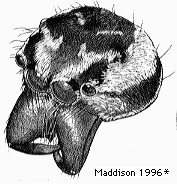 1
1
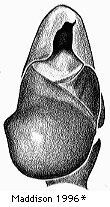 2
2
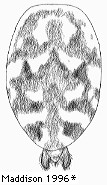 3
3
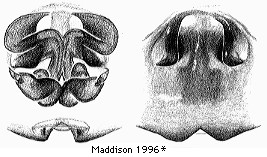 4
4
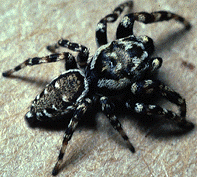 5
5
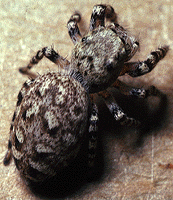 6
6- Male face
- Palpus
- Female abdomen
- Epigynum
- Male (KY)
- Female (KY)
Natural History
In eastern North America this species is generally found in sunlit places such as oldfields, in contrast to P. proterva which is generally more of a forest dweller. In Chihuahua P. galathea lives in riparian vegetation. Horner (1972) has investigated the bionomics and importance of P. galathea in biological control in sorghum. Steiner and Greenstone (1991) examined segregation of isozyme markers in P. galathea.Distribution
Eastern North America north to southern Ontario, west to the Rocky Mountains, south to Florida and Costa Rica.About This Page
Included on this page are images and text from Maddison, W.P. 1996. Pelegrina Franganillo and other jumping spiders formerly placed in the genus Metaphidippus (Araneae: Salticidae). Bulletin of the Museum of Comparative Zoology. l54(4): 215-368. These images and text are copyright © 1996 The President and Fellows of Harvard CollegePage copyright © 1995 Wayne Maddison
All Rights Reserved.
Citing this page:
Tree of Life Web Project. 1995. Pelegrina galathea . Version 01 January 1995 (under construction). http://tolweb.org/Pelegrina_galathea/5044/1995.01.01 in The Tree of Life Web Project, http://tolweb.org/






 Go to quick links
Go to quick search
Go to navigation for this section of the ToL site
Go to detailed links for the ToL site
Go to quick links
Go to quick search
Go to navigation for this section of the ToL site
Go to detailed links for the ToL site